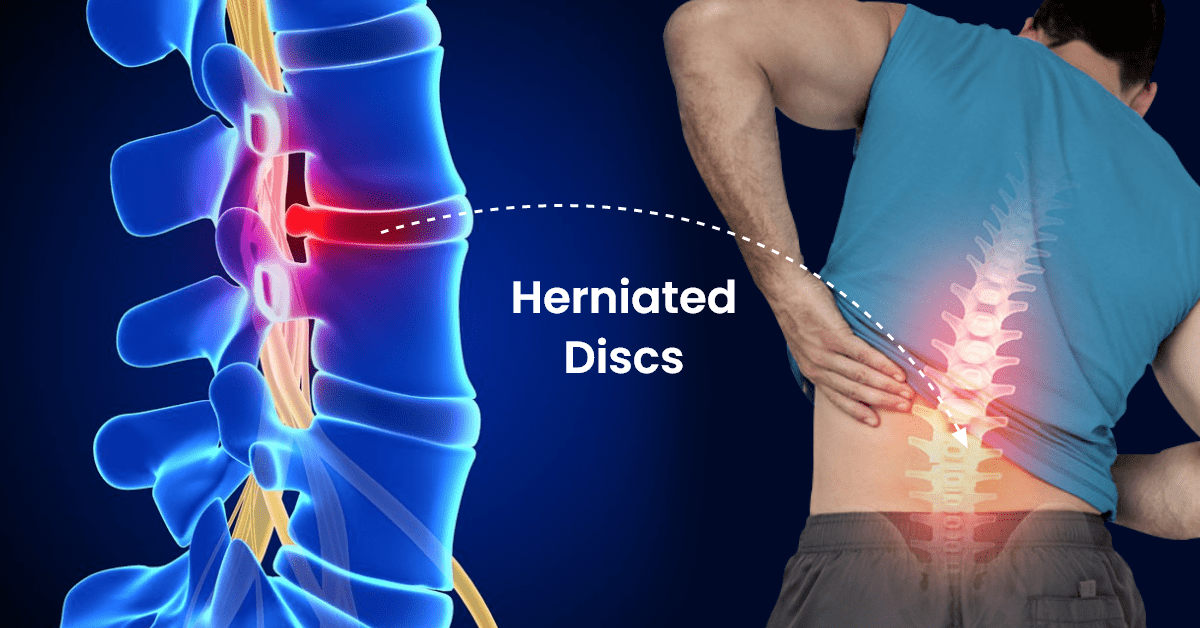Herniated Discs

A herniated disc is when an intervertebral disc bulges or herniates back into the spinal canal. When the disc herniates, it can push on a nerve root or a spinal nerve and causes severe pain. Most herniated discs resolve over time, but they can be very painful during the healing process. A disc bulge involves >90 degrees of the total circumference of a disc and does not extend beyond the boundaries of the annulus fibrosus.
A disc herniation is a rupture of disc material beyond the annulus fibrosus. There are two broad categories, protrusion and extrusion. Protrusion refers to a rupture of disc material in which the base is broader than the dome. In general, this does not extend above or below the disc space. An extrusion is a disc rupture in which the dome is wider than the base, with a dumbbell appearance. Extrusions may extend above or below the disc space.
A free fragment is a displacement of disc material that loses its connection with the main disc material. Such fragments can migrate from the disc space.
Herniated discs can be caused by a number of things including trauma, lifting heavy objects, or using poor posture throughout the day.
How can it be treated?
Herniated disc treatment starts conservatively with physical therapy and medication management. If the pain does not resolve, the patient may be a candidate for an epidural steroid injection, spinal cord stimulation, or other surgical intervention.
Conditions
- Arthritis
- Cancer Pain
- Chronic Pelvic Pain
- Chronic Abdominal Pain
- Cervical Radiculopathy
- Complex Regional Pain Syndrome
- Compression Fractures of the Spine
- Diabetic Neuropathy
- Fibromyalgia
- Herniated Discs
- Knee Pain
- Low Back Pain
- Migraine Headaches
- Neck Pain
- Neuropathy
- Post Laminectomy Syndrome
- Shoulder Pain
- Trigeminal Neuralgia
- Whiplash CAD
Treatments
- Botox Injection
- Capsaicin (8%) Patch
- Cervical Epidural Steroid Injection
- Disc Nucleoplasty
- Dorsal Root Ganglion Stimulator (DRG)
- Endoscopic Discectomy
- Facet Joint Syndrome
- Hip Joint Injections
- Intrathecal Pain Pump
- Intercostal Nerve Block
- Ketamine Infusion
- Knee Joint Injection
- Kyphoplasty
- Lidocaine Infusion
- Lumbar Epidural Spinal Injection (LESI)
- Lumbar Sympathetic Ganglion Block
- Lumbar Radiofrequency Neurotomy
- Minuteman Procedure
- Medial Branch Block (MBB)
- Minimally Invasive Lumbar Decompression (MILD)
- Platelet Rich Plasma
- Peripheral Nerve Stimulation
- ReActiv8 Procedure
- Radiofrequency Ablation (RFA)
- Regenerative Medicine
- SI Joint Injection
- Stellate Ganglion Block
- Sympathetic Nerve Block
- Spinal Cord Stimulation (SCS)
- Spinal Stenosis
- Trigger Point Injection
- Transforaminal Epidural Spinal Injection (TFESI)
- Vertebroplasty
- Vertiflex Procedure
